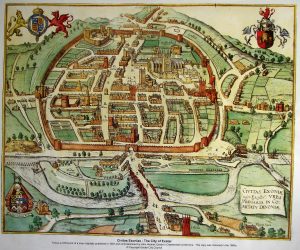 Plague of a Green Man, the second novel in my Lady Apollonia West Country Mysteries, is set in the Devonshire town of Exeter in 1380. At that time, Exeter Castle and the medieval walls surrounding the city centre were impressive, ancient landmarks of the city in addition to its fourteenth century Cathedral, about which I have written in recent postings. In our modern day, we only see surviving evidence of what these constructions might have been in the Lady Apollonia’s day, for the city gates are gone, only ruins of the castle gate survive, and the cathedral’s medieval colour has been tampered with through succeeding generations. Much of the ancient wall remains, and the medieval castle ruins can be visited on the highest point in the old city. In the drawing shown above on the left from the 16th century, you can see the entire wall and the castle in the upper left-hand corner of the city.
Plague of a Green Man, the second novel in my Lady Apollonia West Country Mysteries, is set in the Devonshire town of Exeter in 1380. At that time, Exeter Castle and the medieval walls surrounding the city centre were impressive, ancient landmarks of the city in addition to its fourteenth century Cathedral, about which I have written in recent postings. In our modern day, we only see surviving evidence of what these constructions might have been in the Lady Apollonia’s day, for the city gates are gone, only ruins of the castle gate survive, and the cathedral’s medieval colour has been tampered with through succeeding generations. Much of the ancient wall remains, and the medieval castle ruins can be visited on the highest point in the old city. In the drawing shown above on the left from the 16th century, you can see the entire wall and the castle in the upper left-hand corner of the city.
The castle is called Rougemont because of the red colour of the local Heavitree sandstone used in its construction. The Norman gatehouse is nearly all that survives. It was probably erected by Saxon workman who included double triangular topped windows above the main arch, typically found in Saxon buildings. The other surviving ruin of the castle is Athelstan’s tower along the medieval wall.
Other castle buildings were swept away in the 18th century to make way for the construction of court buildings which were used from 1770 to 2004 when Exeter built newer facilities for its courts. Today much of the area around the castle consists of public gardens and there are some remains of a curtain wall which surrounded that part of the castle not bordered by the city wall.
The city walls of Exeter were first constructed by the Romans and extensively repaired in the Saxon period. Exeter retreated behind its city walls to resist William the Conqueror, but he eventually overcame the city’s defences and erected the eleventh century castle next to the wall as a statement of Norman power.
The city walls are a mixture of grey volcanic stone and red Heavitree sandstone which encircle nearly a mile and a half of the ancient city. About 72% of the medieval wall survives. The locations of many of the former Roman gates correspond to where streets now pass through gaps in the wall: North Street, South Street, High Street (East Gate), and Stepcote Hill (West Gate).
For more on Exeter Castle, click on
https://en.wikipedia.org/wiki/Rougemont_Castle
For more on Exeter’s medieval walls, click on
http://demolition-exeter.blogspot.com/2010/10/exeters-city-wall-2.html
Tags: Chaucer's England, historical fiction, medieval mysteries